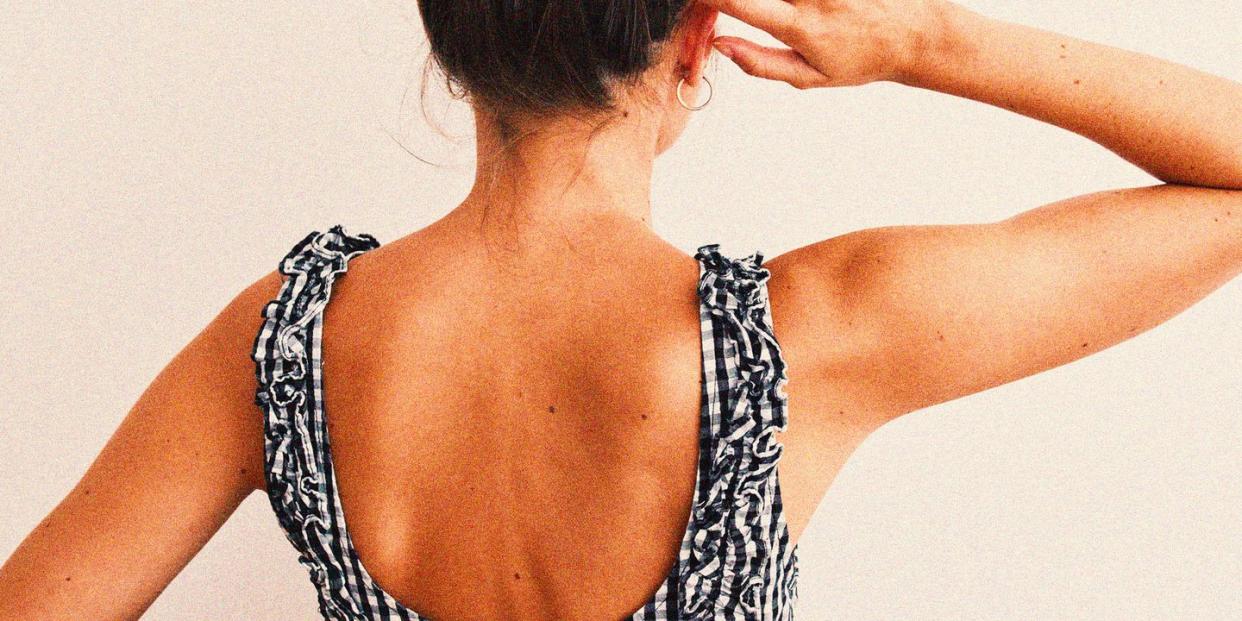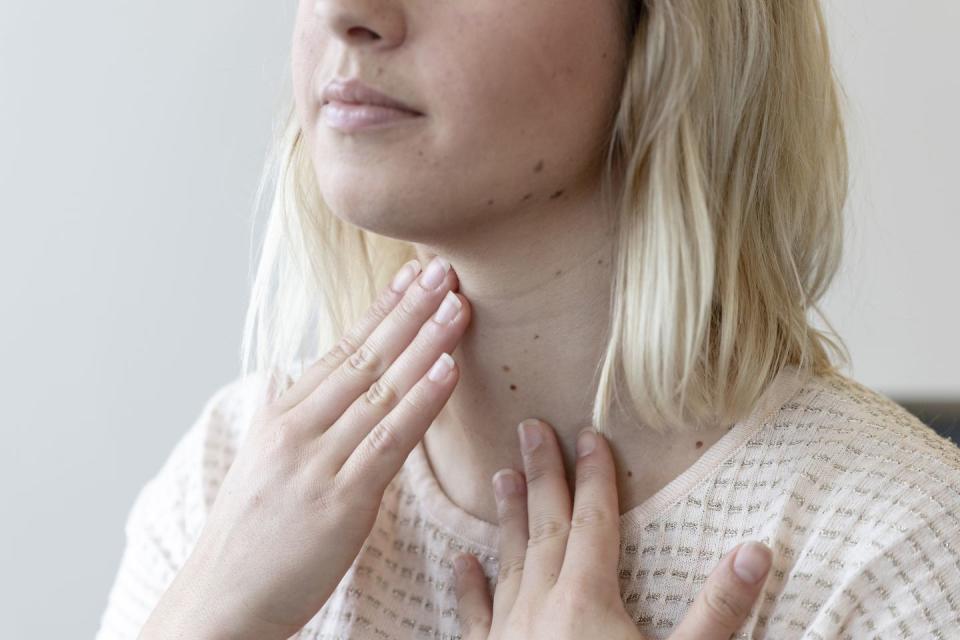"I'm so glad I discovered mole mapping – here's all you need to know about it"

If I cast my mind back several years, I can distinctly recall an ex-boyfriend telling me my back "looks like a Maryland cookie" – which is to say, it is adorned with a generous scattering of moles. As a teenager I was super self-conscious of them, but now in my thirties I've actually come to think they look cool (little quirks like that, after all, are part of what makes us unique).
However, aesthetics aside, I've also come to have another realisation as an adult: unfortunately, for those of us with more moles there's also a higher risk of developing melanoma, a form of skin cancer that can be potentially quite aggressive. Gulp. I have over 100 on my body, which according to Cancer Research is another indicator that I'm more at risk of skin cancers than those with fewer specks. (It's important to note though, just because you have an increased risk of developing a certain disease, it doesn't mean you'll definitely go on to do so).
After a recent melanoma scare, which involved having a suspect looking mark removed from my foot and tested, I've become more conscious than ever about wanting to protect myself from going on to develop any sun-related diseases. Luckily, there are plenty of ways to minimise your risk, ranging from wearing appropriate clothing in the sunshine to layering up the SPF on the daily... and by getting acquainted with a nifty little practice called mole mapping.
Curious to learn more? Step this way.
What is mole mapping?
Mole mapping is fairly new practice carried out by either technicians or dermatologists, depending on which clinic you attend, and involves a machine taking photographs of your entire body. You then have a record of where all your moles are, plus the size, shape, pattern and pigmentation of them. The machine also analyses moles, offering up a risk score which can highlight any the derm might want to take a second look at.
But that's not all! Undergoing a mole mapping also ensures you have a record of your moles, which crucially means that when you pop back for a recurring appointment later down the line, it'll be far easier to spot any changes – something crucial for getting an early diagnosis which leads to a better outcome, should anything untoward be discovered.

"The main purpose of the technology is that for subsequent mole maps, the computer system can then compare previous mole map images with current images, and will highlight any changes in terms of number of moles, size or shape, or any other parameters," echoes Dr Adam Friedmann, who offers mole mapping at the Harley Street Dermatology Clinic (where I experienced the mole mapping procedure in exchange for an honest review. "This enables the the ongoing monitoring of changing moles to be very precise."
The expert dermatologist adds that "modern mole mapping technology deploys an AI algorithm to assess images and predict whether or not there is an increased likelihood of melanoma skin cancer".
At the end of the mole mapping procedure, clients from the Harley Street Dermatology Clinic also receive digital images of their mole map and any specific moles that have been flagged as ones to keep an eye on (either by themselves, the mole mapping machine or the dermatologist).
This, Dr Friedmann explains, allows for self-monitoring to be undertaken much more easily at home.
Who is mole mapping for?
If you're a pale gal like me, it's probably something you should look into – even more so if (also like me) you've got an abundance of moles and freckles. "Skin cancer is much commoner in people with fair skin, rather than in darker skin tones as the natural skin melanin protects from sun damage in darker skinned people," says Dr Friedmann – but that doesn't mean if you have a darker skin tone you should ditch SPF and never bother to check your moles. We should all be doing that and wearing sunscreen.
The doctor also advises that those with other risk factors associated with skin cancer, such as a family history of melanoma, excessive sun exposure or sun bed use, and having previous abnormal moles having been removed, should also consider mole mapping.
Is a mole mapping machine better than a human checking you over?
"In many clinics, mole mapping is undertaken by a technician rather than a consultant dermatologist. In others, the mappings are then overseen by dermatology consultants," notes Dr Friedmann. "In the latter case, there is the benefit of the machines AI algorithm being corroborated by an expert, like a consultant dermatologist."
He goes on to explain that theres "no doubt that the machine is far more precise at highlighting changing moles, because it is able to electronically compare old images using AI technology (no matter how long ago they were taken)" but that the detection of skin cancer and abnormal moles is "about the same when comparing a consultant dermatologist with the AI algorithm, probably because both dermatologists and the AI algorithm use the same criteria to establish whether a mole is potentially cancerous or not."
What is the mole mapping process like?
I first attended a mole mapping appointment in January of last year at the Harley Street Dermatology Clinic and after chatting through my skin history (e.g. family history, previous sunburns etc.) and any concerns with Dr Friedmann, he then used a dermatoscope (a special instrument that's a bit like a magnifying glass) to visually inspect my skin for moles. Note: it's best to strip down to your underwear for this but you are given a gown to protect your modesty and the clinic environment put me at ease.
Next, I headed into another room where the mole mapping machine lives and was instructed by a nurse technician to adopt a series of poses, so that every angle could be captured (including the soles of my feet – a place people often forget to inspect).
Once that I was done, we took some closer photos of a few specific moles that I'd flagged (including two on my abdomen that have slowly grown over the years), and the mole mapping machine assessed the risk of them being cancerous. Luckily, none were noted as being concerning. I then had a chance to chat with Dr Friedmann once more about any worries. A few days later, the report was emailed over to me and I used it as a reference point when self-checking.
When I returned for my follow-up appointment a year later (ideally I should've booked in six months after, but y'know... life happens!), this entire process was repeated plus the moles flagged as abnormal last time (and a few new ones) could now be compared. The nurse showed me on the screen exactly how much or how little the moles had changed in between visits, and the dermatologist then came to look at one which had gotten notably bigger. Thankfully, both he and the machine agreed it looked benign – and I'm super glad I now have a more up-to-date record of all my moles to refer to when I do my routine skin check at home for changes.
What signs suggest a mole might be abnormal?
Whilst the majority of moles are unlikely to be cancerous, it's always good to do regular skin checks. For a more detailed explanation on how to do that, check out Cosmopolitan's guide to monitoring your moles and try to remember the 'ABCDE' rule:
Asymmetrical: "Any mole that starts to become irregular or asymmetrical in shape should raise some concerns," says the doctor.
Border: Is the border poorly defined, or a scalloped-shape? It's worth getting checked out.
Colour: Is the colour different to your other moles? "Any mole in which the pigment starts to change, darken, lighten or become more irregular is worth flagging," says Dr Friedmann. "Skin cancers sometimes have two or three different shades of pale, brown or black."
Diameter: Does the size look unusual compared to your other moles? Take note of that.
Evolving: Has the mole changed shape or size in a notable way? Has it become more raised? Is it bleeding, itchy or painful? These are all signs it's worth getting checked out.
How much does mole mapping cost?
At the Harley Street Dermatology Clinic, the cost of mole mapping with a dermatologist is £385. Other clinics, especially those outside of London, may offer the service at a lower rate but this could also be because it's just a technician who you'll be meeting with during your appointment as opposed to a consultant. Make sure to check who exactly you'll be seen by before confirming any booking.
The NHS offers mole mapping too, however this service is typically only reserved for those who've already been diagnosed with a skin cancer or melanoma.
You Might Also Like


